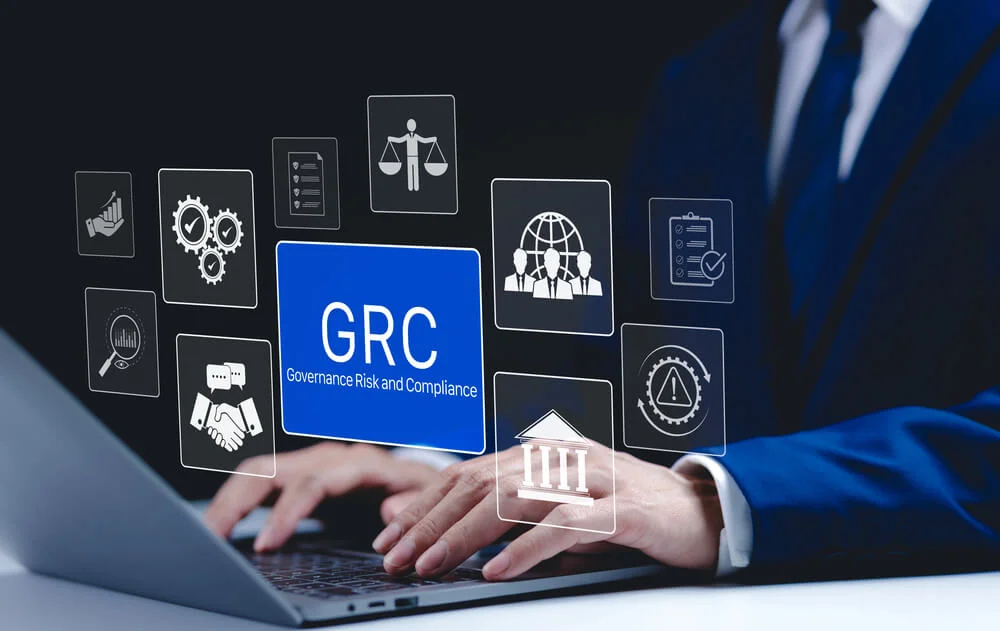At the heart of every successful enterprise is a great staff. To grow and become dominant in your area of operation, your company needs the best and most talented workers who are passionate about your mission. However, each worker creates security risks throughout the employee lifecycle. Learning how to mitigate those risks can help protect the business you are building.

Understanding the Employee Lifecycle
It’s important to take time to understand how a staff member moves through your company and how each phase is unique. At each stage, workers need different types of support, and your business will need to take different precautions to stay secure.
A person starts this relationship before you even hire them. From the moment a prospective candidate responds to your job posting or meets someone from the company at a networking event, they are on the path to joining your company’s ecosystem.
Your human resources team will start making plans to vet candidates for their qualifications, while candidates will evaluate your company’s reputation and decide if they are a good fit. Once you extend an offer and the candidate accepts, the process moves into onboarding and training. These are critical times for human resources to make sure your new employee feels supported.
The employee lifecycle keeps going with training, development, and opportunities for advancement. In some cases, a staff member may climb all the way to the top of the organization. In other instances, a person may decide to leave the company, or you may need to terminate their employment. Both instances have to be handled carefully to maintain relationships.
While many businesses focus on the human side of the worker’s journey, not all give enough attention to the information security side of things. Every stage creates new potential risks, so it is critical to plan ahead and prevent threats from becoming major problems for your workers and for the future of your company.
Risk Management Throughout the Employee Lifecycle
As an employee interacts with your company, you will need to mitigate different risks when it comes to information security. With the right integrations from Compyl, you get a virtual Chief Information Security Officer that offers flexibility for the different needs your company will face. Here are some of the challenges associated with each aspect of employment.
Attracting Talent

Your risk management strategy should start when your company is working to attract people to the organization. Examine how your team advertises your business and how they connect with prospective candidates. Do you use a lot of social media posts or online industry job boards? If so, take a careful look at what information you offer online.
Any posts or publications should avoid giving out information that could lead to compromised credentials. This includes too many specifics about personnel within the company. It’s fine to release information about a hiring manager or point of contact, but limit it beyond that.
Recruiting Candidates
For companies that take a more proactive approach to find candidates, there must be precautions in the recruiting process. The biggest risk in this part of the employee lifecycle may be in the communication process. Your company likely has several secure, monitored channels for communicating internally. External communications are harder to keep safe.
Make sure that you have strong security protocols for your company’s email system. Cyber attacks that come in via email are becoming more and more common. During the recruiting process, your staff may be handling attachments in the form of resumes and other employment documents. Opening these poses a big risk to your system, so it is important to monitor email.
If you’re hiring managers use other systems to chat with prospective workers on company devices, and have rules in place for what platforms are allowed and how to monitor threats on them. This adds another layer of protection and accountability for the company.
Onboarding New Hires
Once a person has signed on to join your company, you will move to the next phase of the employee lifecycle: onboarding. This is a time that has a lot of potential risks for security lapses. Your human resources and technology teams are working to add a new person to all of your systems, creating credentials and granting critical access to important databases.
This process can be very slow if it is unorganized. According to Helpnet Security, only about 15% of new workers get all the access they need to be productive on their start date. Many have to wait days and weeks to be fully integrated into a company’s operation. Not only is this bad for productivity, but it also creates security gaps.
During those early days when a new employee is waiting for access, they may still be training with current workers. In some cases, another person may let the new worker use someone else’s credentials just for the sake of continuing training. This means usernames and passwords are less secure. Compromised credentials are the most common angle of attack for cyber breaches.
Having consistency within your security team and integrating their work with that of human resources and training managers can eliminate a lot of these concerns. Your IT security team can get word of a new hire from human resources, generate usernames and access for the new worker on the appropriate platforms and check with the manager that they have covered all bases.
Training and Developing Workers
Moving forward in the employee lifecycle, your company can mitigate risks with proper security training. Just as you train new staff on their job responsibilities, you should also have a robust cyber risk training program. This is especially important in the world of financial services and insurance, where a breach can cost millions of dollars and cause irreparable harm to the company’s reputation.
Each employee should have training on the most common types of attacks that your business is likely to face, how to use the tools you have to block those attacks and how to report issues to the security team. You should also make it clear what your policies are when it comes to transferring data and protecting credentials.
Workers should revisit this training and education as they stay and grow with the organization. It’s easy to think that a seasoned worker understands the rules and won’t stray from them. However, people have a tendency to get comfortable and let down their guard. Over time, they may become complacent and pay less attention to the risks threatening the company.
Risks and cyber threats are also evolving, so you must make sure that your company adapts to the new styles of attacks that bad actors are constantly coming up with. Compyl’s team makes it a point to monitor the modern cyber environment to keep your team up-to-date. This is another benefit of having a virtual Chief Information Security Officer. Adjustments can happen quickly.
Monitoring compliance is another important aspect of reducing risks during the employee lifecycle. As your organization grows, it becomes tougher to track activities across different departments and levels of management. Compliance software is a great option to keep everything on track and alert the right people when something is going wrong.
Expanding Management
When your company is growing and thriving, you will have workers who move from entry-level into management roles. Sometimes these will be established management positions, and your new leader will have a clear set of responsibilities and privileges to follow and adhere to. In other cases, you will find yourself creating new management roles. That means creating new security rules as well.
When an employee moves into a leadership position, you must decide what kind of access he or she will have to sensitive information. Will this person have employees that report to them? If so, the new manager will likely need access to personnel records. Will they need higher-level access to your databases and servers? You have to answer these questions as you create new roles.
At this phase of the employee lifecycle, new training is a must. In addition to knowing your company’s general security policies, your new manager now also needs to learn how to properly handle employee records. They may need a briefing on the proper management of financial information or other sensitive data.
You must address these concerns because you are creating another person who is a target for attack due to their proximity to valuable information. This person needs to know that they may be held to a higher standard because of this.
Separating Properly
A sensitive topic in managing workers while reducing security risks is employee separation. There are many reasons a person will leave a company. They may retire after a long career or resign to pursue a different opportunity. In some cases, a business may decide to terminate the worker’s employment. No matter the reason, a business must handle separation carefully.
The offboarding process creates new potential for leaks and security gaps. A critical step to take is exit training. Make sure your IT and human resources teams take the time to talk to the employee who is leaving and go over the proper ways to handle the information they learned during the employment period, as well as information about clients and accounts.
If there were any legal notices signed at the beginning of employment about handling trade secrets, client information or other knowledge that is important to the company, this is the time to review those notices and make clear the expectations and obligations. A worker should know that even though this is the end of their employee lifecycle with your company, they still have certain duties to uphold.
You should also monitor the behavior of employees who are approaching the end of their time with your organization. Hopefully, the parting is on good terms, and everyone wishes the other parties well. However, this isn’t always the case. Your security team should watch for irregular access to databases, file movements, and data transfers.
There should also be a plan to eliminate access for employees who leave the company. Do you know how you will revoke access to remote systems as well as physical properties? Your IT team will need to invalidate the former employee’s usernames and passwords and revoke access to any facilities. Your company should have a way to move an employee’s records to an archive file.
By following the entire journey as a worker moves through your company, you can reduce the risks of security lapses and breaches that could do a lot of damage to your enterprise.
The Benefits of Managing Risk in the Employee Lifecycle
It’s often said that people are the most valuable asset to any operation, and this is true. Imagine how hard it would be to manage clients and gain new business without the right people. However, human error is also one of the biggest risks to an organization, and your team has to account for it to stay successful.
By managing risk from the start of the employee lifecycle, you become more proactive and head off problems before they become damaging to your company. When you wait until there is a problem, you will find yourself playing catch-up. It is very hard and costly to fix a breach while also instituting new training to address whatever went wrong.
Adding risk management to your workers’ journey also creates a sense of unity and understanding. Everyone knows what’s expected of them and their co-workers, and they can work together to protect the company. A unified stance increases accountability as well because everyone understands the right way to do things from the start.
Your business is too valuable to take a wait-and-see approach to address the potential risks that come with the employee lifecycle. From workers’ first interactions to their parting moments, you must create an environment that puts security first and doesn’t compromise on the need for compliance and regulation. Create a solution that works for you with Compyl today.




